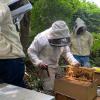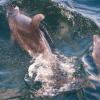Mapping The Return Of Acroporid Corals On Fringing Reefs Along The West Coast Of Barbados
Up until the 1980s, Acropora species were among the dominant coral reef building species in the western Atlantic and considered a key component in a healthy reef system. However, Acropora species experienced precipitous declines in population density, colony size, and overall health starting in the late1970s, largely as a result of the region-wide, genus-specific white band disease epidemic, acting together with other local stressors such as poor water quality and over-fishing. Western Atlantic Acropora species are now listed on CITES Appendix II, as “Critically Endangerd” by the IUCN, and as “Threatened” under the US Endangered Species Act. More recently there have been several reports suggesting that these species may be starting to recover in some locations across the Caribbean. In Barbados, anecdotal reports and photographs indicate a potential recovery of acroporids in several locations along the west and south coasts of the island. The potential recovery of acroporids on nearshore reefs in Barbados is of particular interest to the Government’s Coastal Risk Assessment and Management Programme (CRMP) and is the subject of the current study. A total of 46 fringing reefs were surveyed along the west coast of Barbados from Six Mens Bay in the north to Batts Rock in the south, from June 13th to August 22nd 2015, by free-divers. The GPS co-ordinates, appearance, condition and size of every Acropora spp. colony found were recorded. A total of 707 colonies, consisting of both A. palmata and A. prolifera, were found and their positions were added to a detailed benthic habitat map. Colonies were found along the entire west coast and overall were most abundant in the spur and groove and reef crest zones of the fringing reefs. Abundance and density were generally low and varied considerably among reefs, although there was no obvious spatial pattern along the coast. Correlation analyses with reef area and various secondary datasets on indices of reef health indicated that both Acropora spp. abundance and density were significantly and positively correlated with mean % live coral cover and with Diadema urchin density although the latter relationship was driven by a single reef with exceptionally high densities of both. More acroporids were found on larger reefs, but reef area does not appear to be influencing colony density. General tissue lesions (likely caused by a combination of disease and predation) were apparent on almost half the colonies, and their frequency of occurrence increased with colony size. Likewise the occurrence of boring Christmas tree worms was common, being present on just over a quarter of the colonies, and also positively correlated with colony size. Presence of predatory snails (9.6% colonies) and fireworms (< 1%) fell within the lower end of the ranges reported by other studies, and was not strongly influenced by colony size. This study reports on the very early stages of a recovery of acroporids on the fringing reefs along the west coast of Barbados and provides a valuable detailed baseline dataset to guide conservation and rehabilitation efforts, and for comparative studies to monitor recovery success in the future. The results are particularly relevant to the ongoing work of the Government’s CRMP with a focus on rehabilitating west coast fringing reefs.
Area of Interest: Barbados
Year: 2016




